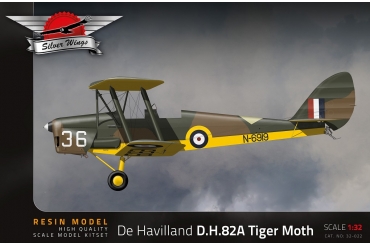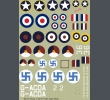De Havilland D.H.82A Tiger Moth
- Cat. No.:
- 32-022
- Material:
- resin
- Scale:
- 1:32
- Period:
- 1931-1944
- Marking options:
- 6 (UK, USA, Finland, Netherlands)
- Number of parts:
- 107 x resin, 45 x pe, film
- Length & wingspan:
- 228 x 279 (mm)
- Additional features:
- main elements iron reinforced
- Price:
-
History
It is one of the world's most popular trainers of the 1930s.
After the end of hostilities, sport aviation became very popular. Many pilots, after returning from the war, still flew in civilian life. More and more people were fascinated by the idea of flying. The need of designing cheap, safe and simple in service aircraft, arrived. The harbinger of the family of such an aircraft of the de Havilland Aircraft Company was the D.H. 60 Moth. Flown for the first time in 1925 it became the first successful sport aircraft in the world. The next, differed only with the engine used, became a big commercial success.
The D.H.82 Tiger Moth was designed in 1930 as a two seat primary trainer of mixed construction, fully in accordance to the British Air Ministry standards. The first flight took place on the 28th October 1931 and the first serial aircraft reached the RAF training centres by in 1932. In the same year, instructors of the Central Flying School demonstrated an inverted flight on the D.H.82 during the air show at Hendon. Due to its outstanding flight characteristics it was approved for full aerobatics, blind flying and operating from rough terrain, which, in the case of a school aircraft is not meaningless.
To make bailing out from the front seat easier, the upper wing was moved forward and side opening doors were used. This biplane belonged to the popular family of "Moth" aircraft and recognised by the characteristic vertical stabiliser of the de Havilland family. It was one of the world's most popular trainers. Other aircraft types based on the Tiger Moth were the D.H.82 Queen Bee (a radio controlled pilotless target, which first flew in 1935) and the Tuxton Jackaroo (a four seat touring aircraft). Also since 1987 there has been a Tiger Moth display team, called the Diamond Nine.
The D.H.82 Tiger Moth's were the standard machines of the Polish Air Force flying schools in Great Britain in 1940–1946. In Canada, Australia, Sweden, Norway or Portugal Tiger Moths were used until the 1950's. Many of these machines still fly today.
• De Havilland D.H.82A Tiger Moth, MO-159, LeLv26, Finnish Air Force, 1943
• De Havilland D.H.82A Tiger Moth, PG-712/2, Royal Netherlands Air Force, 1946
• De Havilland D.H.82A Tiger Moth, N6919/36, probably of No 1 EFTS, RAF, 1940
• De Havilland D.H.82A Tiger Moth, G-ACDA, De Havilland School of Flying, Hatfield, 1933
• De Havilland D.H.82A Tiger Moth, DE745, assigned to the 353rd Fighter Group, USAAF Station 366 (RAF Metfield), September 1943
• De Havilland D.H.82A Tiger Moth, R4922, used by 7 Elementary Flying Training School, Desford and Braunstone, 1939-1945


















